
17 minute read
Ski Racer Alex Tilley
BRITISH ATHLETE FINDS GENDER EQUALITY IN SKI RACING

Advertisement
BY PIERA VAN DE WIEL
As a child, I met current rising star for British ski racing Alexandra “Alex” Tilley at the British Ski Academy in Les Houches, France, a place where young girls and boys eager to ski fast, flock to perfect their craft, breaking records and paving the way for a career in ski racing. Now, 26-year-old Tilley is a member of the Great Britain Alpine World Cup Ski Team with European and world championships under her belt, including the PyeongChang 2018 Olympics with her team coming fifth in the team event. I sat down with Tilley off the slopes to discuss her successful career in ski racing and the home she and I both found in the sport — a home where men and women are valued equally.
FROM SCHOOL STUDENT TO FULL-TIME ATHLETE Born in Torphins, a village in Aberdeenshire, Scotland, Tilley started ski racing when she was 8 years old at her local club, the Gordon Skiers, and she never looked back. Her passion for racing continued to grow. “I just loved challenging myself in some way, and skiing was a great way to do it,” Tilley said. “It wasn’t until I was about 15 [years old] that I really started to appreciate the ski racing lifestyle and it made me realize that I wanted to take it a little more seriously. I definitely appreciated my time in the mountains at the British Ski Academy more than I did my time in the school classroom.”
She then decided to leave school to pursue her ski racing career, a bold decision that paid off. “I never had any real ambition to go to university or to further my studies,” Tilley said. “I spent so much time away from school in my later years, I slowly started to realize I didn’t have a lot in common with many of the people in my peer group at school, but I was starting to build some really strong relationships in the ski world.”
This felt right to Tilley and she learned how to become a full-time athlete. Alex Tilley sports an awesome goggles tan off the slopes. (Photo/ Vanessa Fry)
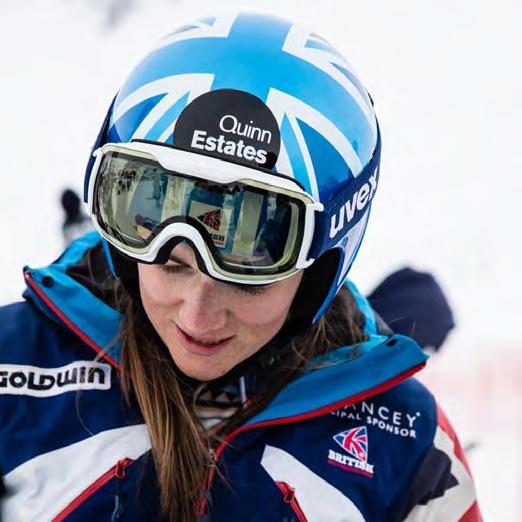
IT TAKES DISCIPLINE Tilley races in the technical disciplines, which are giant slalom and slalom. However, she loves to spend time on her Super G skis to feel the true meaning of speed down the slopes. Her favorite is giant slalom where she has had the most success and feels she has the biggest potential.
Tilley’s training program changes a lot during different periods of the season. She spends her summers focusing on her fitness with road biking and weights lifting. During the winter months, it’s about managing energy levels during training so she’s ready for the stacked race program ahead. Her ambition is “to ski about six to eight runs of high quality, with high focus training each day, and maximize recovery and rest time as [she] travels between venues.”
Having representation and role models to look up to is important when training to be a ski racer. American ski racer Lindsay Vonn and British racer Chemmy Alcott were those female leaders for our generation. There wasn’t one ski racer who didn't have their signatures signed in permanent ink on
Alex Tilley at PyeongChang Winter Olympics. (Photo/Andy Ryan)
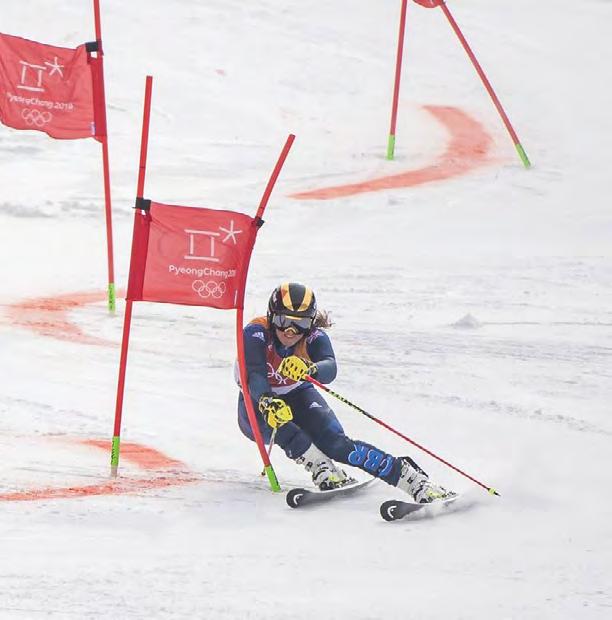
their catsuits. Tilley, as a British ski racer, looks up to Chemmy and has always appreciated her input and advice.
Another inspiration to Tilley is Dave Ryding, who is gaining huge respect for British skiers. His work ethic and commitment are even more impressive than his results and he is a great role model for any young athlete.
other. “It’s fun to see some of the younger ones who are so passionate about the sport, pushing themselves to be better,” she said.
Having ambition, drive and goals within the sport is also incredibly important. Tilley aspires one day to win a World Cup race. She remarked, “That feeling of being the fastest in the world on that day would be something quite special.” When setting and achieving goals, you can put a lot of pressure on yourself, but Tilley reminds herself “just to enjoy what it is to be a skier.” She added, “Our lifestyle lends itself to seeing and experiencing so many amazing places, and it can be so easy to forget those parts when you get stressed about results.”
Racing is about having command of your mind and your body and it’s imperative to train both. It takes patience and time, and for Tilley, she loves to work with mindfulness and making sure she is present and in the moment, so she is not distracted by the thoughts and anxieties of race day.
Ultimately, Tilley feels it is important to not try to live up to the picture that has been painted and to add extra pressure on yourself. She feels that if you stay honest and open with yourself, you can take confidence from what you have achieved, not who you think you are.
EQUALITY Equal representation in sports is often unbalanced, particularly when discussing equal pay between the male and female players. However, when chatting about this with Tilley, she stated, “I have to say that I think ski racing is probably one of the few sports where females are equally supported as the males. Mikaela Shiffrin has out earned the best men over the past two seasons of ski racing, and I feel a lot of pride in our sport for that reason. I certainly feel like my sponsors, Quinn Estates, see me as an equal to the male athletes, and that is really important.”
Tilley hopes that this equal support continues to spread to athletes across the board in all disciplines of sports in the world.
EVOLUTION Developing into a role model for younger ski racers, she stays at Team Evolution during the season, often around some of the younger racers. Sometimes they even train alongside each
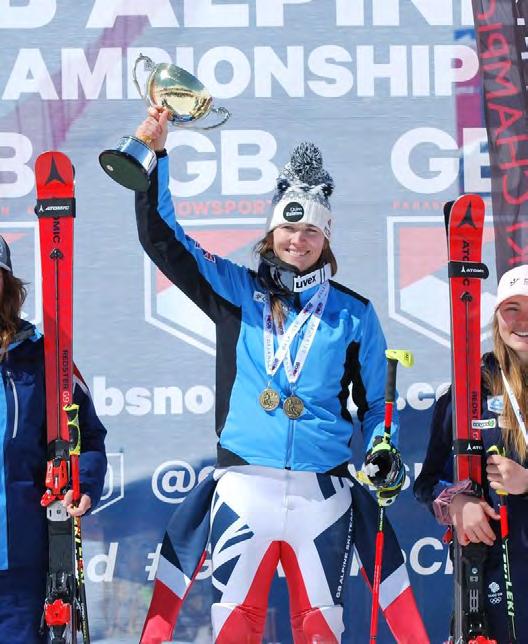
8 ISSUES FOR JUST $12.99
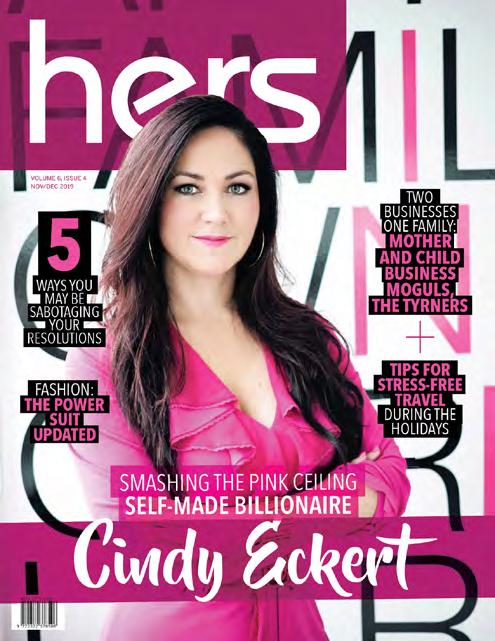
FEATURES • HEART • FLAVOR • H E A L T H LESSONS • WORK • PLAY
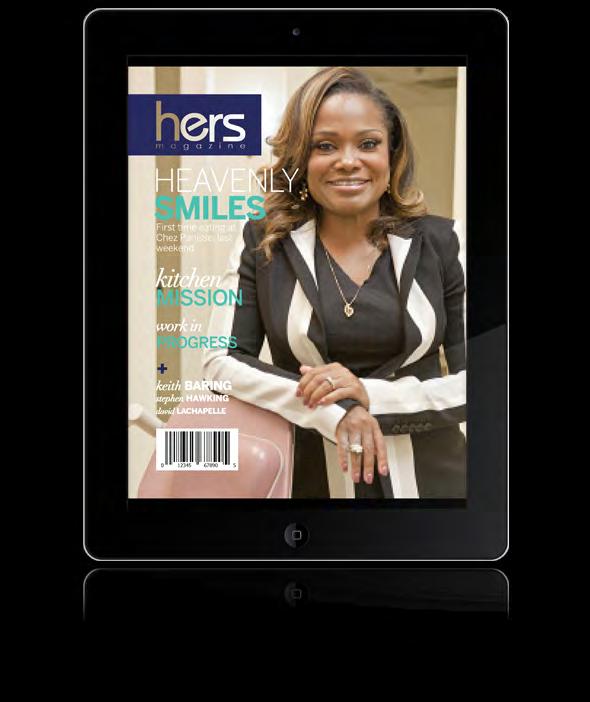

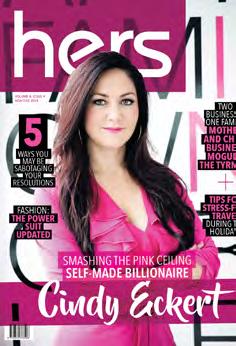
TIPS FOR EVERY KIND OF GROUP FITNESS FIRST-TIMER
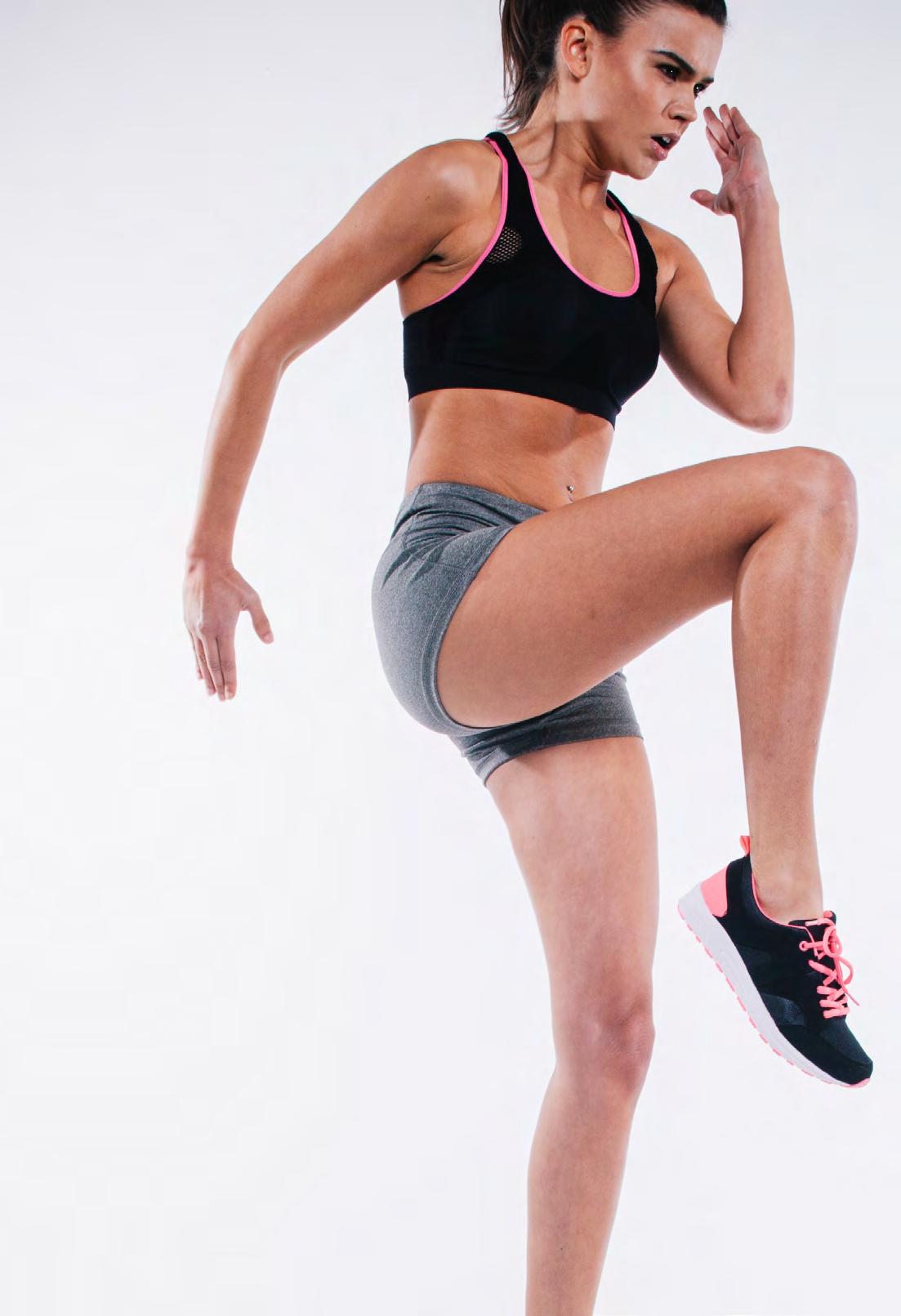
BY HANNAH CHALKER
For those new to fitness, walking into a group exercise can be intimidating. At larger gyms, you may find it difficult to get started as there are so many options to choose from. The rise of boutique gyms offers more specified workouts, typically focusing on a specific type of exercise. A boutique fitness studio is a small gym that focuses on group exercise and specializes in one or two areas of exercise. The boutique experience is more intimate than that of larger gyms, as the groups are smaller. We interviewed several specialists from different fitness boutiques in order to best prepare you for your new workout adventure. If you’re scared to go alone, grab a friend who is also interested in exercise!
YOGA
For those who are looking for a calm mind and fullbody workout, Kelly Tuner, E-RYT and Director of Education for YogaSix, the nation’s leading boutique yoga brand, offers the following tips for your first yoga class:
Eat light “Eat something with a nice balance of calories from protein, fat and carbs to give you fuel a couple of hours before the practice, Tuner said. “You shouldn’t be hungry, but you also should avoid being full.”
Come Hydrated “The most important suggestion I make for people before coming to their first yoga practice is to come hydrated,” Tuner said. “Make sure you’re drinking enough water in the 24 hours leading up to that initial practice to avoid feeling faint as you start to sweat.”
Dress for Success “It should come as no surprise that you will likely sweat while taking your first yoga class,” Tuner said. “Because of the sweat, form fitting attire tends to hold up better in the practice than baggy, loose clothing that get weighed down with the sweat.”
Customize Your Practice “Implementing modifications that suit your body is key,” Tuner said. “Using blocks in your yoga practice is a great way to modify poses, without compensating the integrity of the movement.”
FAQS FOR YOGA NEWCOMERS ANSWERED BY KELLY FROM YOGASIX
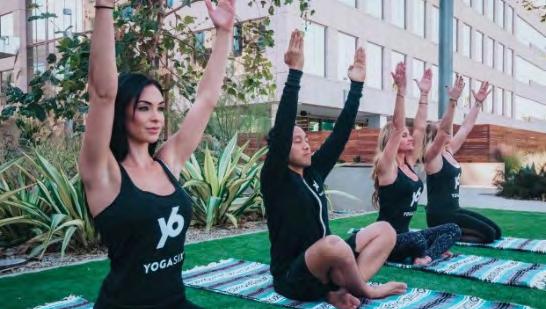
What equipment should a yoga newcomer bring for their first class? “The great thing is, you don’t need much,” Tuner said. “Typically, you want to bring a yoga mat and a bottle of water. If you’re taking a heated or more vigorous style of yoga, you might consider bringing a yoga mat towel (or even a beach towel) to put on the mat to absorb sweat. A lot of studios offer mat and towel rentals, so if you are just testing it out you might rent one before investing in your own.”
What makes yoga your ideal mind and body workout? Why should people try it out? “I’ve never regretted a yoga class,” Tuner said. “I always leave feeling physically better in my body, and calmer and clearer in my mind. It’s a win-win… you won’t regret it.”
What are the benefits of taking a group fitness class? “Accountability and community! It’s great to build relationships with a studio – the teachers, the other students, the staff – as a way to feel connected and committed to returning,” Tuner said. “Plus, many studios are well equipped with great facilities and amenities, such as supportive flooring, comfortable environment (like added heat and humidity), props. Best of all, you’re less likely to be distracted by your cell phone, your computer, or your cat.”
ROWING
For your first rowing class, Caley Crawford, NASM CPT and Director of Education for Row House, a high-energy and low-impact boutique rowing concept, offers the following:
Seek Help for Setup “Correct setup in the footholds and starting position on the rower is essential for maximizing the benefits of the workout and preventing injuries,” Crawford said.
Proper Rowing Technique “Take the rowing sequence slow at first: catch, drive, finish and recovery,” Crawford said. “Sixty percent of the movement comes from your legs, 30 percent core, and 10 percent arms.”
Sit Near the Front “The front row may seem daunting, but the most seasoned rowers and instructor are there, so you are surrounded by individuals with strong technique to mirror,” Crawford said.
Be Ready to Transition “Most rowing classes consist of work on and off the rower, so be prepared for bursts of cardio and bodyweight exercises next to your erg,” Crawford said.
Modify Moves as Needed “Don’t be afraid to dial down the intensity of the workout or a particular exercise or ask the instructor for additional options,” Crawford said. “They want everyone to succeed!”
FAQS FOR NEW ROWERS ANSWERED BY DEB AVERATT, A MASTER COACH AT ROW HOUSE

What makes rowing workouts unique from other kinds of exercise? Rowing works 86 percent of your muscles and your core is active the entire time,” Averatt said. “It's a great way to get an efficient and effective workout for the entire body. I also love that it gentle on my joints and promotes great posture.”
How did you get interested in rowing and what was your first lesson/class like for you? “I have always loved rowing, which might sound strange to some of you, but I truly have,” Averatt said. “Little did I know, I was rowing all wrong before Row House! Caley trained me how to utilize my body properly and safely, and now I love it more than I ever have. It's a great core and glute strengthener, which have always been the hardest muscles for me to activate properly, and now, wowzers, I have sure seen results! Rowing is for sure a sport and I feel like I'm always learning something new in how to better my form just slightly or how to generate a bit more power which all results with burning more calories and getting a better workout.”
What are the benefits of taking a group fitness class? “I love group fitness, but especially at Row House,” Averatt said. “We work as a team and we leave no rower behind. The encouragement and community that comes from working out in a group cannot be beat. I love working as a team utilizing our boat split to motivate me to work harder. Everyone is chipping in to rack up our team meters by using their own intensity. It's energizing and super fun!”
STRETCH

Flexibility Isn’t Mandatory “Don’t worry if you aren’t flexible,” Martinez said. “All group stretches are led by a trained professional who will let you know how to customize each stretch based on your level of flexibility.” Wear Loose Clothing “Come in something comfortable that allows for freedom of movement and full range of motion,” Martinez said. “You don’t want to rip your favorite pair of skinny jeans!” Plan Your Stretch Before or After A Workout “Group stretches are great for performance recovery after a workout or sporting event, but they can also be an awesome warm-up for upcoming activity,” Martinez said. If you plan to partake in an assisted stretching session at a local gym or boutique, Austin Martinez, MS, CSCS, ATC and Director of Education for StretchLab, an assisted stretching boutique, recommends the following:
FAQS FOR THOSE NEW TO STRETCHING ANSWERED BY AUSTIN MARTINEZ FROM STRETCHLAB What are some of the benefits of assisted stretching? “There are multiple benefits to stretching, including but not limited to: increased muscle flexibility, increased mobility, increased joint range of motion, injury prevention, aid with muscle recovery post-workout, aid with sports performance and decreased stress/tension,” Martinez said. “Assisted stretching, when done with a trained professional, can ensure individuals are fully receiving these benefits. They will ensure the stretch is held for the right amount of time, targeting the needed muscle groups and will apply the right amount of tension needed to get optimal results.” Walk me through what a typical stretch class looks like. “For a one on one session at StretchLab, the client would walk in to be greeted by a Front Desk Associate and promptly checked in for their appointment,” Martinez said. “Soon after, their Flexologist will come to the front for introduction. Then the Flexologist take them to the back of the studio to complete a movement assessment test with our MAPS machine. The Flexologist will discuss the assessment results with the client and head to one of our stretch benches. As the session starts, the Flexologist will gather more pertinent questions from the client and begin to build rapport. From there, the Flexologist will take the client through various stretching techniques with the intent to create muscle relaxation and flexibility. Sessions are 25 minutes or 50 minutes.”
Wear Grip Socks “These socks ensure a stretch without slipping and falling,” Martinez said.
What are the benefits of taking a group fitness class? “In our group classes, clients learn various stretching and myofascial release techniques (foam rollers), taught by a trained Flexologist,” Martinez said. “The philosophy is ‘teach them how to fish,’ by giving the clients the education and tools to take their health/wellness into their own hands. This is led in a dynamic format for 50 minutes.”
CYCLE
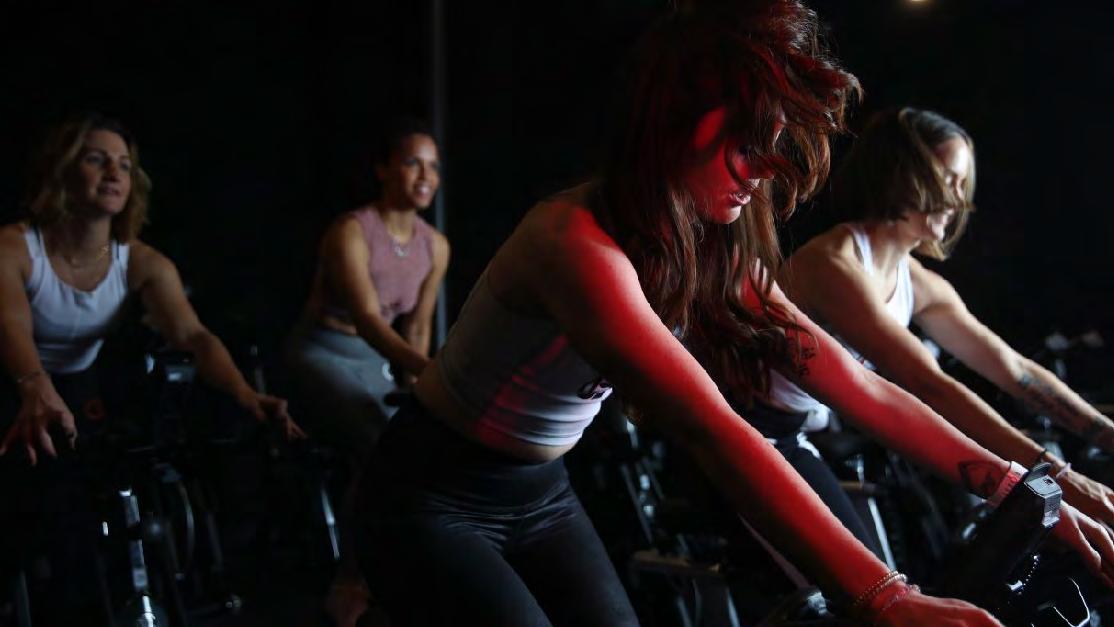
One of the most popular modalities of group fitness, indoor cycling classes can be intimidating, so Tevia Celli, Director of Education for CycleBar, the world’s largest boutique indoor cycling franchise, offers the following:
Work at your own pace “At studios like CycleBar, first-time riders should feel empowered to stay seated, as the choreography out of the saddle is optional,” Celli said. Fuel Your Body “Eat something before your workout so you have energy: a banana, bar or some nuts are great choices,” Celli said. Hydrate “Drink plenty of water before, during and of course after your ride to keep your body replenished,” Celli said. Stretching Is Key “Since most fitness classes only have a couple minutes built in at the end to stretch, make sure as a newcomer, you take extra time after class because you will be engaging muscles you don’t normally use,” Celli said. Do Not Be Intimidated “Everyone riding with you also had their first class once,” Celli said. FAQS ABOUT CYCLING ANSWERED BY TEVIA CELLI FROM CYCLEBAR Why do you think cycling has become such a popular workout choice? “Indoor cycling has become such a popular workout choice because it’s so highenergy and boutique studios like CycleBar elevate the experience to a new level with fun lighting, playlists and a party-like atmosphere,” Celli said. “Community is also a big part of indoor cycling, which helps drive its popularity. The workout is also low impact so it’s not damaging to the joints and you can do it often without breaking down your body.” Describe why it is important to stretch after the class. What kind of stretches should be done? “It is so important to stretch after class because your muscles, particularly those of your lower body, just worked very hard for 45 minutes,” Celli said. “Pedaling and resistance on the bike can make your muscles tight and you need to release that tightness and lactic acid buildup. A few of the best stretches to do after a cycling class include a hamstring stretch, quadriceps stretch, and gluteal stretch. If your chest and shoulders are tight, a chest-opening stretch will feel great after class.” What are the benefits of taking a group fitness class? “Of course, there are tons of physical benefits to taking a group fitness class, but the mental and social benefits are also huge,” Celli said. “Community is a major aspect of indoor cycling classes. People who may not have necessarily bonded outside of the studio, bond through an unspoken support while sweating together, which then evolves outside the studio and can turn into amazing friendships that last a lifetime. Feeling great about your body and looking great is just a nice side effect!”
RUN
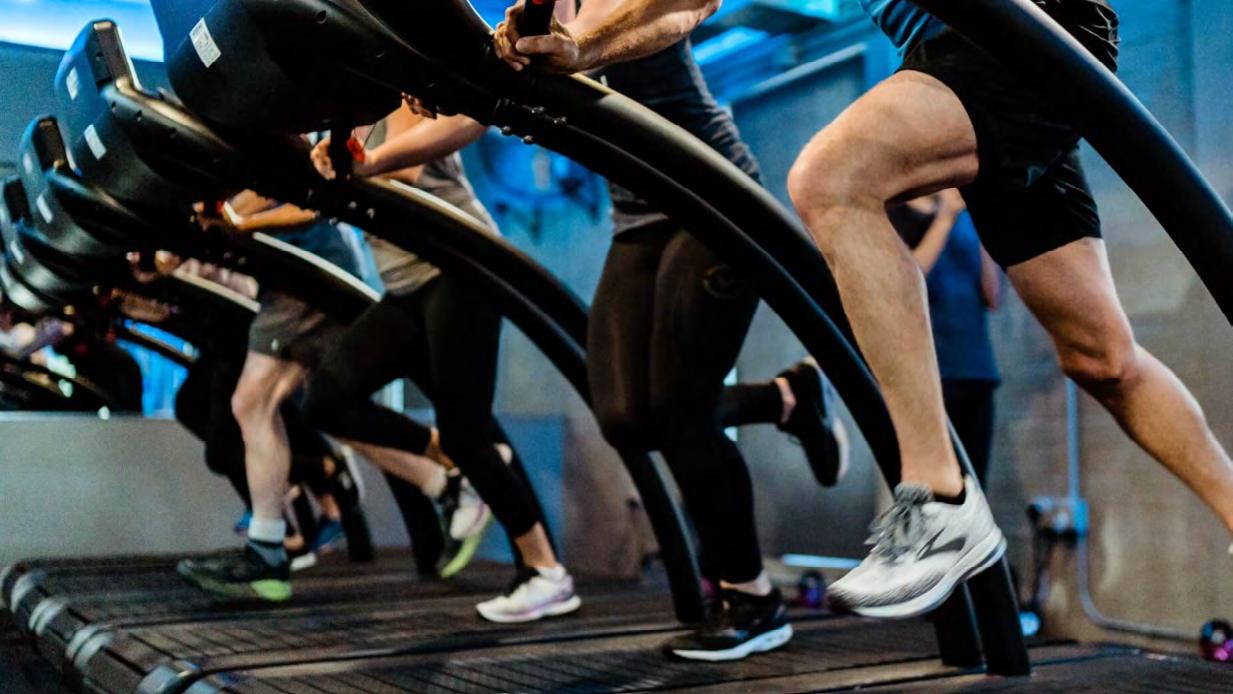
Not everyone knows what to expect when taking their first indoor running class, so Steve Stonehouse, NASM CPT, USATF and Director of Education for STRIDE, a new boutique fitness concept that is reinventing the definition of a runner, offers the following: Get There Early “Some people prefer the back row, while others prefer not being by right in front of a mirror or being close to the door,” Stonehouse said. “These classes fill up quickly so pre-book and get there early to make sure you get the treadmill you prefer.” Go at Your Own Pace “Everyone is focused on their own pace and intensity levels,” Stonehouse said. “Don’t worry about trying to set a new personal record on your first day. Just have fun!” Eat and Hydrate “Like with any high intensity exercise, make sure you eat one and a half to two hours before class,” Stonehouse said. “Proper nutrition and hydration are key.” FAQS FOR NEW RUNNERS ANSWERED BY STEVE STONEHOUSE FROM STRIDE Describe for me what a typical indoor running class looks like. “At STRIDE, you’ll find 25 Woodway treadmills and an interactive light/music experience,” Stonehouse said. “Created with every level in mind, our 55-minute signature STRIDE class is perfect for beginners, seasoned marathoners, and everyone in between. You’ll be coached through alternating intervals of running or walking and active recovery to optimize your workout and build endurance, but you control your speed and incline to best fit your experience level and personal goals. Expect to cover 2-6 miles each class, depending on pace.” What are the benefits of indoor running versus outdoor? “One main benefit is the experience is controlled,” Stonehouse said. “Temperature, lighting and terrain just to name a few. Also, for women in particular, running outdoors can cause safety concerns that are also eliminated in an indoor running studio.”
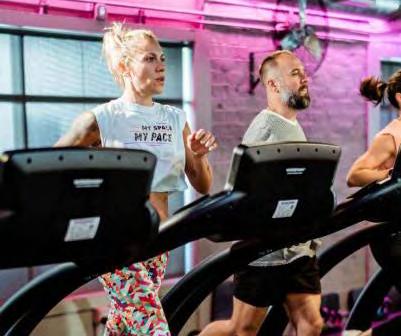
What are the benefits of taking a group fitness class? “The biggest benefit to training with a group is the community that is created,” Stonehouse said. “I think people are communal by nature. This community helps with everything from motivation, accountability and consistency.”










